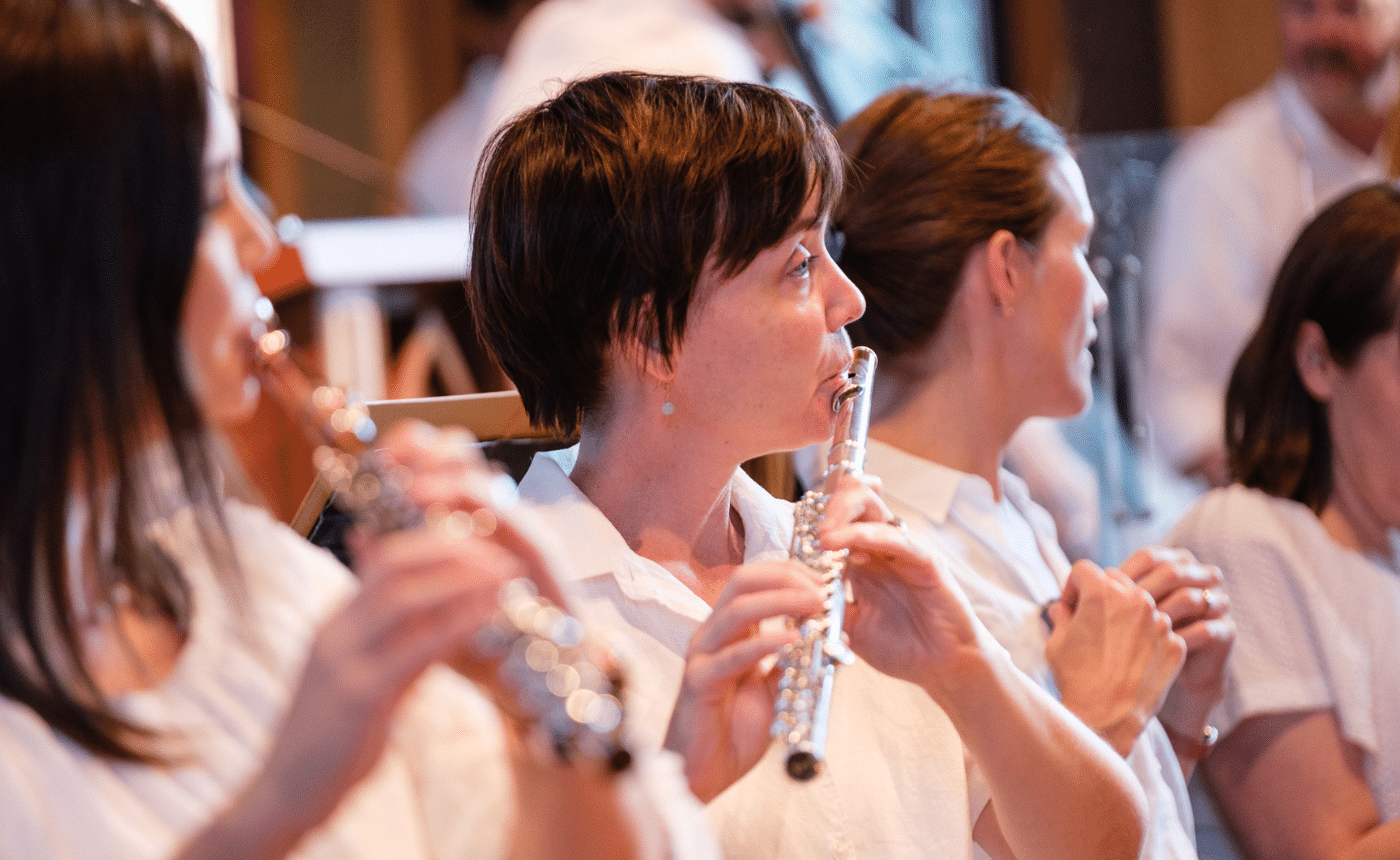What to Listen for in Messiaen’s Des canyons aux étoiles
Commissioned in 1971 by the American philanthropist and arts patron Alice Tully to celebrate the bicentenary of the Declaration of Independence, Des canyons aux étoiles is a suite of twelve orchestral movements arranged in three groupings of five, two and five. When all twelve are performed together, the movements are operatic in scope, spanning more than an hour and a half.
Though most of Olivier Messiaen’s music was not written specifically for religious settings, virtually all of it expresses religious feeling. A devout Roman Catholic, Messiaen found the divine presence everywhere in nature, most especially in the songs of birds. All of his compositions reflect the deeply held religious faith that he constantly refreshed in his observations of nature.
Musical “scene paintings” that depict the natural world — perhaps Vivaldi’s The Four Seasons is the most famous example — are not uncommon in classical music, but no composer approached Messiaen in combining direct imitation of the sounds of nature with metaphorical expressions of divine creation. Born in 1908, Messiaen entered the Paris Conservatory at the age of 11. His wide-ranging musical influences span rhythmic patterns from classical Greek and Hindu sources and melodies based on modes of transposition he developed from his own early compositions; he also experimented with “total serialism,” an almost epistemological application of 12-tone “rows,” and with Eastern musical sources including Japan and Indonesia.
If all this sounds mystical, perhaps it is. But Messiaen’s deepest musical influence — apart from his Roman Catholic faith — was almost certainly his devotion to nature and in particular his love of birds. He was an accomplished ornithologist, and as a composer took the time to transcribe bird songs as musical notation. He was devoted to the teachings of St. Francis of Assisi. To Messiaen’s admirers, his music and his life are inseparable; they seem to be the worldly evidence of a saintly life, and his music reveals a sincerity of expression that seems as simple as nature itself in the listening, regardless of the complexity of its sources.
Commissioned in 1971 by the American philanthropist and arts patron Alice Tully to celebrate the bicentenary of the Declaration of Independence, Des canyons aux étoiles is a suite of twelve orchestral movements arranged in three groupings of five, two and five. When all twelve are performed together, the movements are operatic in scope, spanning more than an hour and a half.
Like Ferde Grofé’s Grand Canyon Suite, Messiaen’s Dans canyons aux étoiles is intimately connected to a particular place in the American Southwest — in this case, the state of Utah. Messiaen took inspiration from the landscape and the birds of the Beehive State while composing this suite, and was particularly moved by visiting Bryce Canyon National Park. In these movements, Messiaen’s musical reflections on Utahn grandeur — the meanings he discerned “written in stars,” the colors and forms he saw in the desert — describe his experiences of Bryce as a divine creation. He composed Dans canyons aux étoiles… based on his detailed notes from visits to Bryce Canyon and Zion Park, always listening intently to the sounds of nature and transcribing the melodies in his notebooks. At Cedar Breaks the composer regarded the “wild and colorful beauty – a vast amphitheater plunging into a deep gorge.” In his notebook, he wrote the words “immense solitude.”
1. “Le Désert” (“The desert”)
In the first movement of Des canyons aux étoiles, Messiaen’s musical reflections on Utahn grandeur witness the meanings he discerned “written in stars,”and the colors and forms he saw in the desert.
2. “Les orioles” (“The orioles”)
Olivier Messiaen’s musical evocation of the sounds of nature, such as the orioles in Des canyons aux étoiles, stands apart from examples of scene-painting by other composers. A lifelong student of ornithology who heard the voice of God in the songs of birds, Messiaen listened to nature with the ear of a documentarian and a prophet as well as a composer. His work in transcribing bird songs in musical notation is unequaled in the history of composition. His dedication and his reverence are evident in “Les orioles.”
3. “Ce qui est écrit sur les étoiles” (“What is written in the stars”)
In sections like “Ce qui est écrit sur les étoiles” that engage full orchestra, Messiaen’s instrumentation goes to unusual lengths to emulate nature — for example, in its unusually large percussion section, requiring five percussionists to take charge of a wind machine, a thunder sheet, various gongs, bells, maracas, whip, bass drum, triangle wood block, crotales, reco reco, tumba, and an instrument of Messiaen’s own invention, the geophone — a large drum filled with thousands of lead pellets.
4. “Le Cossyphe d’Heuglin” (“The white-browed robin-chat”)
At the other extreme, section IV, “Le Cossyphe d’Heuglin” (The white-browed robin-chat) is for solo pianist. But it requires an instrumentalist who can achieve a practically trance-like communion with Messiaen’s recreation of a bird in the wild. Messiaen created this movement, like much of his piano music, for his wife, the pianist Yvonne Loriod. The white-browed robin-chat, or Heuglin’s robin, is a beguiling songbird found mainly in Africa whose “chat” is a melodious and highly variable song heard at dawn and dusk.
5. “Cedar Breaks et le don de crainte” (“Cedar Breaks and the gift of awe”)
Messiaen considered the feelings of awe he expresses in the Cedar Breaks movement to be a gift of the Holy Spirit. In his notebook he described the area’s “wild and colorful beauty – a vast amphitheater plunging into a deep gorge.” He remarked on its “immense solitude.” Perhaps no other composer could have combined both a literal recreation of the sounds of nature with original, classically composed music. The influential British composer and conductor Oliver Knussen noted: “Certainly a fantastic rushing sound (‘development of the sound of the wind’) from the whole orchestra” [in this movement] was a most effective stroke.”
6. “Appel interstellaire” (“Interstellar call”)
Composed in 1971, the “Interstellar Call” is the earliest of the suite’s twelve movements, and was originally created to memorialize Messiaen’s friend Jean-Pierre Guézec, a French composer who died that year at age 36. The sounds of the horn haunt us in this movement with a call that is somehow intimate yet infinitely distant.
7. “Bryce Canyon et les rochers rouge-orange” (“Bryce Canyon and the red-orange rocks”)
During his time in Utah, Messiaen was particularly moved by visiting Bryce Canyon National Park. The suite’s movements describe his experiences of Bryce as a divine creation. The cathedral-like grandeur of the park’s rock formations echoes through movement seven.
8. “Les Ressuscités et le chant de l’étoile Aldebaran” (“The resurrected and the song of the star Aldebaran”)
In the eighth movement of the suite, what we hear is quite literally Messiaen’s rendering of the music of the stars: a song of resurrection and of the star Aldebaran. The brightest star in the constellation Taurus, Aldebaran glows red in the heavens and is the fourteenth-brightest star in the night sky. Messiaen’s starscape transports us from the suite’s intimate observation of the nature around us to the furthest reaches of the heavens, finding the unity of divine creation in both — our small, fragile earth and the infinity of space.
9. “Le Moqueur polyglotte (“The mockingbird”)
The ninth, tenth, and eleventh movements of Des Canyons aux étoiles showcase the music of birds, a sound that Messiaen evoked with a kind of inspired precision that no other composer has ever matched. Messiaen knew his birds, and in their song he quite literally heard the voice of God and the glories of divine creation.
10. “La Grive des bois” (“The wood thrush”)
In movement ten, “Le Grive de bois,” we hear the song of the wood thrush, a bird that may be found in southwestern American locations such as Bryce Canyon as well as Mexico and Central America.
11. “Omao, leiothrix, elepaio, shama” (“Omao, leiothrix, elepaio, shama”)
In the eleventh movement, Messiaen’s horizon widens to include species that can only be heard far from Utah: the omao, leothrix, elepaio and shama, indigenous to Africa and the Hawaiian Islands. All are small songbirds that physically resemble the wood thrush — but, clearly, Messiaen wants us to hear the differences.
12. “Zion Park et la cité céleste” (“Zion Park and the celestial city”)
The consummation of Messiaen’s vision is expressed in the twelfth movement, “Zion Park and the Celestial City,” a paean to the glory of all creation.












